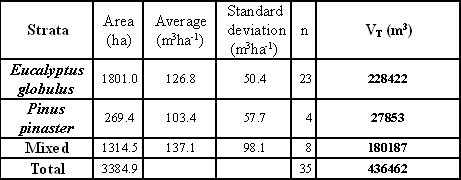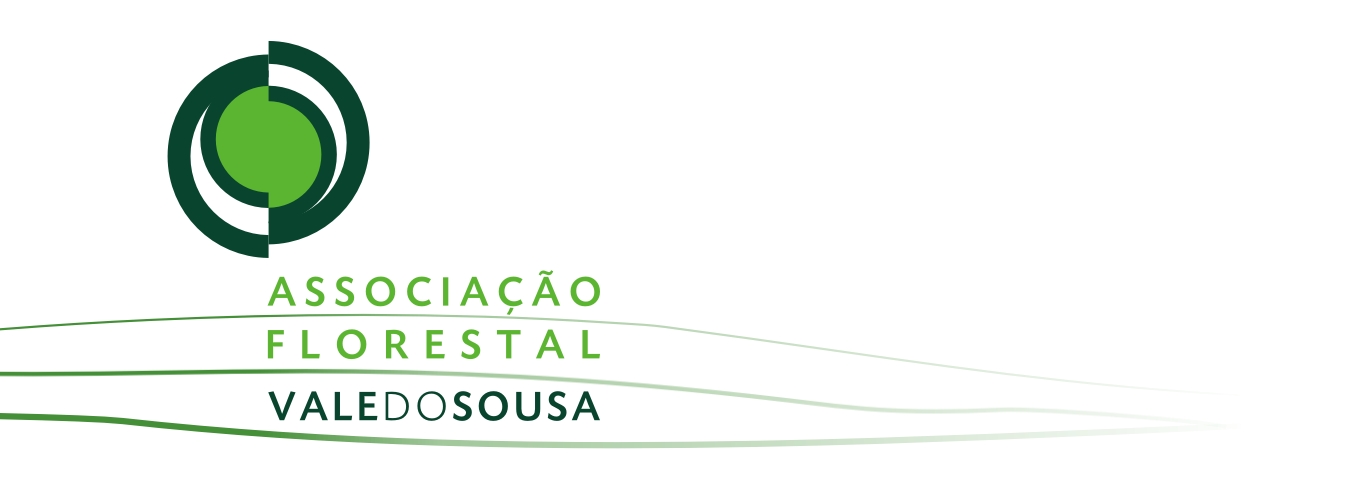Percentage of the total forest
area in Sousa Valley: 14,3 %
No of plots: 35
Costs
TOTAL COST:
1227,3 €
Costs/ha: 0,24 €
Costs/plot: 35 €
The total cost includes:
1- Data collection: 959 €
2- Data analysis: 268,3 €
Results
Growing stock in the South of Paredes in 2005

Sources: UTAD estimates
Error assessment (for a confidence level of 95%)

Sources: UTAD estimate
(Note: not all the numbers represent significant figures)
Remarks
The Portuguese National Forest Inventory definition of growing stock differ in some aspects from FAO definition:
a) FAO (FRA 2005 guidebook) defines growing stock as the volume (m3) over bark of all living trees. FAO also requires information on the national thresholds and the part of the trees that are included in the volume.
b) Portuguese IFN (1995) defines growing stock as the living component of the existing volume.
Growing stock calculated by North Portugal team refers to the total volume of the stem over bark of all living trees of the main species with a minimum height of 1.30 m.
Commercial growing stock was not calculated.
Data to evaluate growing stock was obtained through the inventory measurements in 35 plots implemented in half of the municipality of Paredes. The volume of the trees belonging to species that only appears once or twice in the plots (like Quercus sp.), were not included in the calculations. The result for the overall growing stock considering all species together is 438105 111691 m3.
Total volumes were obtained using stratified systematic sampling formulas. Results show that it would be needed a higher sampling intensity to obtain a reliable estimation of the growing stock, especially for pine stands and mixed stands of pine and eucalyptus.
Problems and improvements
Results show that the traditional sampling intensity and sampling scheme applied in the region by the local FOA - plot layout of 800 800 m- might not be the best to obtain estimations of the total growing stock in the pilot zone with an acceptable sampling error. It is not expected to obtain better results with the Portuguese NFI plot layout since it uses a wider distance between the inventory plots.
Other reason for the high sampling errors is the heterogeneous dimensional distribution of pine stands and mixed stands existing in the coast of North Portugal.
To improve the reliability of data for this indicator in the pilot zone, one suggests the replacement of the actual stratified systematic sampling scheme by a Neyman allocation and the increase of sampling efforts. Neyman allocation takes into account differences in stratum variability (see the difference in standard deviations values of volume for pure and mixed stands) as well as stratum size in sample allocation (not necessarily taken into account with a systematic layout as shows the results of the first table). Besides, this optimal allocation can be adjusted to take in account costs for different stratum sampling.
Comments and conclusions
The assessment of this criterion is already well documented by the forest scientific community. However, the assessment under FORSEE project, which covered different regions of 4 countries and different forest types, pointed out some interesting issues that might be important to remain. From North Portugal case study, with pure and mixed forests, one underline the following points:
a) Growing stock definition is not the same across all the regions (e.g. total/commercial volume under/over bark; minimum dimension of the trees);
b) There must be put efforts in the inclusion of the volume of the trees belonging to species that are rare in the plots (Quercus sp.) in the growing stock results;
c) Reliable information on growing stock requires reliable sampling data
Growing stock is not considered by Criterion 1 of Portuguese Norm 4406 2003.




Initiative Communaitaire FEDER
INTERREG IIIB Espace Atlantique